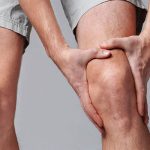 A hinge joint between the femur and the tibia.
A hinge joint between the femur and the tibia.
A joint in the middle of the leg, joining the femur and the tibia.
Joint complex, fronted by the kneecap (patella), at which the thighbone (femur) and lower leg connect. It includes joints at which the femur and tibia (a lower leg bone) meet, a joint where the femur and patella meet, and numerous ligaments and bursae.
The hinge joint between the thighbone (femur) and the shin (tibia). This powerful joint joins the two longest bones in the body and helps bear much of the weight of the upper body. The kneecap (patella) is a disk of bone that lies in front of the knee joint. The kneecap is cushioned above and below by an upper and a lower bursa (sac of synovial fluid).
The joint formed by the femur, tibia and patella (knee-cap). Its cavity consists of three joints fused into one, separated in part by ligaments and folds of the synovial membrane. The ligaments which bind the bones“ together are extremely strong, and include the popliteal and the collateral ligaments; a very strong patellar ligament uniting the patella to the front of the tibia; two cruciate ligaments in the interior of the joint; and two fibro-cartilages, which are interposed between the surfaces of tibia and femur at their edge. All these structures give the knee-joint great strength, so that it is seldom dislocated. The cruciate ligaments, although strong, sometimes rupture or stretch under severe physical stress such as in contact sports or athletics. Surgical repair may be required, followed by prolonged physiotherapy.
The articulations formed by the distal femur, proximal tibia, and the patella.
The knee is a hinge joint connecting the femur (thighbone) and the tibia (shinbone). The front of this joint is shielded by the patella (kneecap).
Two cartilaginous discs, known as menisci, cover the surfaces of the femur and tibia to minimize friction. Bursas, which are fluid-filled sacs, are found above and below the kneecap and at the back of the knee, offering cushioning for the joint. External ligaments on the knee’s sides give support, while cruciate ligaments inside the joint prevent excessive straightening and bending. The quadriceps muscles located at the thigh’s front extend the knee, while the hamstring muscles at the thigh’s rear allow it to bend.
Knee injuries are prevalent and can range from ligament strains, meniscus tears, patella dislocations, to fractures of the associated bones. Chondromalacia patellae, a painful inflammatory issue, is often seen in teenagers. Additionally, conditions like knock-knee and bowleg are temporary deformities frequently observed in children.
The articulation point connecting the femur and the tibia, or the front portion of the leg in the vicinity of this joint.
